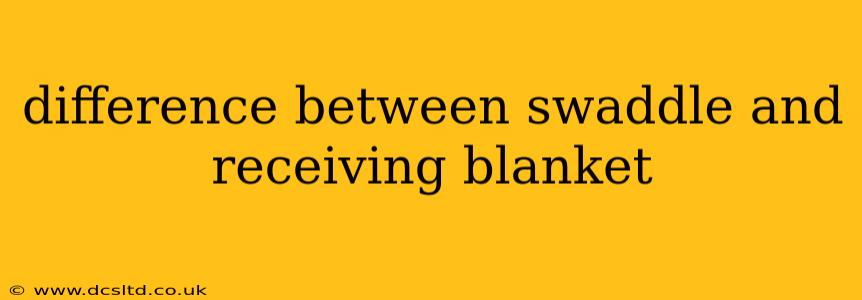Choosing between a swaddle and a receiving blanket for your little one can feel overwhelming. Both are soft and comforting, but they serve very different purposes. Understanding their key differences will help you select the right item for your baby's needs and your parenting style. This comprehensive guide will delve into the specifics, addressing common questions parents have about these baby essentials.
What is a Swaddle?
A swaddle is a piece of fabric specifically designed to wrap a baby snugly, mimicking the feeling of being held. It usually has either Velcro, zippers, or ties to secure the baby's arms and legs in a comfortable position. The primary purpose is to provide a sense of security and comfort, often helping babies sleep longer and more soundly. This snug containment can also reduce the startle reflex, a common cause of waking in newborns.
Benefits of Swaddling:
- Improved Sleep: The secure feeling helps babies sleep for longer stretches.
- Reduced Startle Reflex: Keeps baby's arms from startling themselves awake.
- Sense of Security: Mimics the feeling of being held, providing comfort and reassurance.
- Temperature Regulation: Can help keep baby warm, especially in cooler environments (always monitor baby's temperature).
What is a Receiving Blanket?
A receiving blanket is a large, soft square of fabric, typically made of cotton, muslin, or fleece. Unlike a swaddle, it doesn't have any closures. Its primary use is for wrapping or covering a baby, offering warmth and a comforting texture. They are incredibly versatile and serve various purposes throughout your baby’s early life.
Uses for a Receiving Blanket:
- Warmth: Provides an extra layer of warmth for your baby, particularly when transitioning from the car seat or stroller.
- Nursing Cover: Offers privacy during breastfeeding or bottle feeding.
- Burp Cloth: Acts as a soft and absorbent burp cloth to catch spit-up.
- Car Seat Cover: Provides an additional layer of warmth or protection from the sun in a car seat (never use as a restraint!).
- Playmat: Offers a soft surface for tummy time (always supervise).
- Comfort Item: A familiar, soft blanket can be a soothing comfort for your baby.
What are the Key Differences?
The core difference lies in their functionality and design. Swaddles are designed for wrapping a baby tightly, while receiving blankets are designed for covering or providing a layer of warmth and softness. Swaddles typically have closures to secure the baby's arms, whereas receiving blankets are open and flexible.
When Should I Use a Swaddle vs. a Receiving Blanket?
Swaddles are best for newborns and infants who benefit from the snug, secure feeling. However, it's crucial to stop swaddling once your baby shows signs of rolling over, typically around 2-4 months of age, to reduce the risk of SIDS. Receiving blankets are suitable from birth onwards and can be used throughout your baby's development for various purposes.
Can I Use a Receiving Blanket as a Swaddle?
While some parents attempt to use a receiving blanket as a swaddle, it's generally not recommended. A properly designed swaddle offers a more secure and controlled wrap, minimizing the risk of the baby becoming loose or overheating. The lack of closures in a receiving blanket makes achieving this secure wrap difficult and potentially unsafe.
How do I choose between a swaddle and receiving blanket?
Consider your baby's temperament and sleep habits. If your baby is easily startled or struggles to self-soothe, a swaddle might be helpful. A receiving blanket is a versatile addition to any baby's wardrobe, offering comfort and practicality for many situations, regardless of swaddling preference.
This comprehensive guide should equip you with the knowledge to choose between a swaddle and a receiving blanket based on your baby's needs and your preferences. Remember, always prioritize your baby's safety and comfort.
